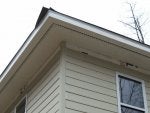Hi,
I wanted to know what is the best option to terminate the exhaust vent for a ceiling mounted bathroom exhaust fan, would it be exiting at the roof (vertically) or along the ceiling at exiting at the soffit (horizontally)? I've had experiece that when installed at the roof, wind opens the vent lid and snow enters and water eventually drips down the vent... But I've also heard that exiting at the soffit can cause vapour to leak back into the attic... any advice welcome, thanks!!!
But I've also heard that exiting at the soffit can cause vapour to leak back into the attic... any advice welcome, thanks!!!
I wanted to know what is the best option to terminate the exhaust vent for a ceiling mounted bathroom exhaust fan, would it be exiting at the roof (vertically) or along the ceiling at exiting at the soffit (horizontally)? I've had experiece that when installed at the roof, wind opens the vent lid and snow enters and water eventually drips down the vent...








